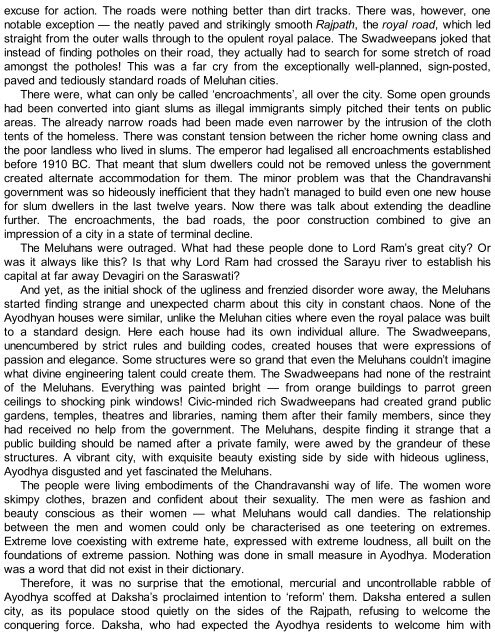the immortal of maluha
Create successful ePaper yourself
Turn your PDF publications into a flip-book with our unique Google optimized e-Paper software.
excuse for action. The roads were nothing better than dirt tracks. There was, however, one<br />
notable exception — <strong>the</strong> neatly paved and strikingly smooth Rajpath, <strong>the</strong> royal road, which led<br />
straight from <strong>the</strong> outer walls through to <strong>the</strong> opulent royal palace. The Swadweepans joked that<br />
instead <strong>of</strong> finding potholes on <strong>the</strong>ir road, <strong>the</strong>y actually had to search for some stretch <strong>of</strong> road<br />
amongst <strong>the</strong> potholes! This was a far cry from <strong>the</strong> exceptionally well-planned, sign-posted,<br />
paved and tediously standard roads <strong>of</strong> Meluhan cities.<br />
There were, what can only be called ‘encroachments’, all over <strong>the</strong> city. Some open grounds<br />
had been converted into giant slums as illegal immigrants simply pitched <strong>the</strong>ir tents on public<br />
areas. The already narrow roads had been made even narrower by <strong>the</strong> intrusion <strong>of</strong> <strong>the</strong> cloth<br />
tents <strong>of</strong> <strong>the</strong> homeless. There was constant tension between <strong>the</strong> richer home owning class and<br />
<strong>the</strong> poor landless who lived in slums. The emperor had legalised all encroachments established<br />
before 1910 BC. That meant that slum dwellers could not be removed unless <strong>the</strong> government<br />
created alternate accommodation for <strong>the</strong>m. The minor problem was that <strong>the</strong> Chandravanshi<br />
government was so hideously inefficient that <strong>the</strong>y hadn’t managed to build even one new house<br />
for slum dwellers in <strong>the</strong> last twelve years. Now <strong>the</strong>re was talk about extending <strong>the</strong> deadline<br />
fur<strong>the</strong>r. The encroachments, <strong>the</strong> bad roads, <strong>the</strong> poor construction combined to give an<br />
impression <strong>of</strong> a city in a state <strong>of</strong> terminal decline.<br />
The Meluhans were outraged. What had <strong>the</strong>se people done to Lord Ram’s great city? Or<br />
was it always like this? Is that why Lord Ram had crossed <strong>the</strong> Sarayu river to establish his<br />
capital at far away Devagiri on <strong>the</strong> Saraswati?<br />
And yet, as <strong>the</strong> initial shock <strong>of</strong> <strong>the</strong> ugliness and frenzied disorder wore away, <strong>the</strong> Meluhans<br />
started finding strange and unexpected charm about this city in constant chaos. None <strong>of</strong> <strong>the</strong><br />
Ayodhyan houses were similar, unlike <strong>the</strong> Meluhan cities where even <strong>the</strong> royal palace was built<br />
to a standard design. Here each house had its own individual allure. The Swadweepans,<br />
unencumbered by strict rules and building codes, created houses that were expressions <strong>of</strong><br />
passion and elegance. Some structures were so grand that even <strong>the</strong> Meluhans couldn’t imagine<br />
what divine engineering talent could create <strong>the</strong>m. The Swadweepans had none <strong>of</strong> <strong>the</strong> restraint<br />
<strong>of</strong> <strong>the</strong> Meluhans. Everything was painted bright — from orange buildings to parrot green<br />
ceilings to shocking pink windows! Civic-minded rich Swadweepans had created grand public<br />
gardens, temples, <strong>the</strong>atres and libraries, naming <strong>the</strong>m after <strong>the</strong>ir family members, since <strong>the</strong>y<br />
had received no help from <strong>the</strong> government. The Meluhans, despite finding it strange that a<br />
public building should be named after a private family, were awed by <strong>the</strong> grandeur <strong>of</strong> <strong>the</strong>se<br />
structures. A vibrant city, with exquisite beauty existing side by side with hideous ugliness,<br />
Ayodhya disgusted and yet fascinated <strong>the</strong> Meluhans.<br />
The people were living embodiments <strong>of</strong> <strong>the</strong> Chandravanshi way <strong>of</strong> life. The women wore<br />
skimpy clo<strong>the</strong>s, brazen and confident about <strong>the</strong>ir sexuality. The men were as fashion and<br />
beauty conscious as <strong>the</strong>ir women — what Meluhans would call dandies. The relationship<br />
between <strong>the</strong> men and women could only be characterised as one teetering on extremes.<br />
Extreme love coexisting with extreme hate, expressed with extreme loudness, all built on <strong>the</strong><br />
foundations <strong>of</strong> extreme passion. Nothing was done in small measure in Ayodhya. Moderation<br />
was a word that did not exist in <strong>the</strong>ir dictionary.<br />
Therefore, it was no surprise that <strong>the</strong> emotional, mercurial and uncontrollable rabble <strong>of</strong><br />
Ayodhya sc<strong>of</strong>fed at Daksha’s proclaimed intention to ‘reform’ <strong>the</strong>m. Daksha entered a sullen<br />
city, as its populace stood quietly on <strong>the</strong> sides <strong>of</strong> <strong>the</strong> Rajpath, refusing to welcome <strong>the</strong><br />
conquering force. Daksha, who had expected <strong>the</strong> Ayodhya residents to welcome him with



